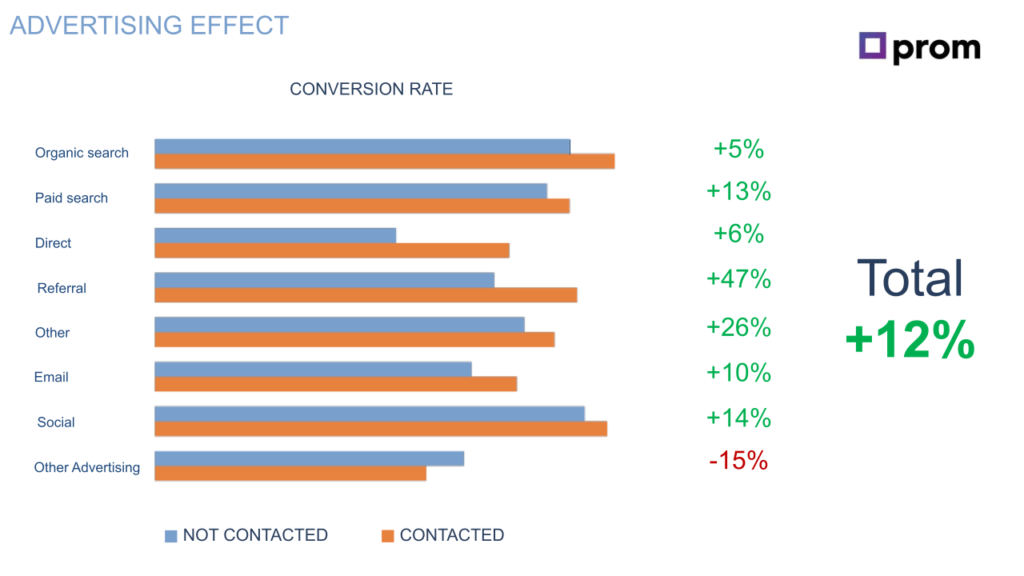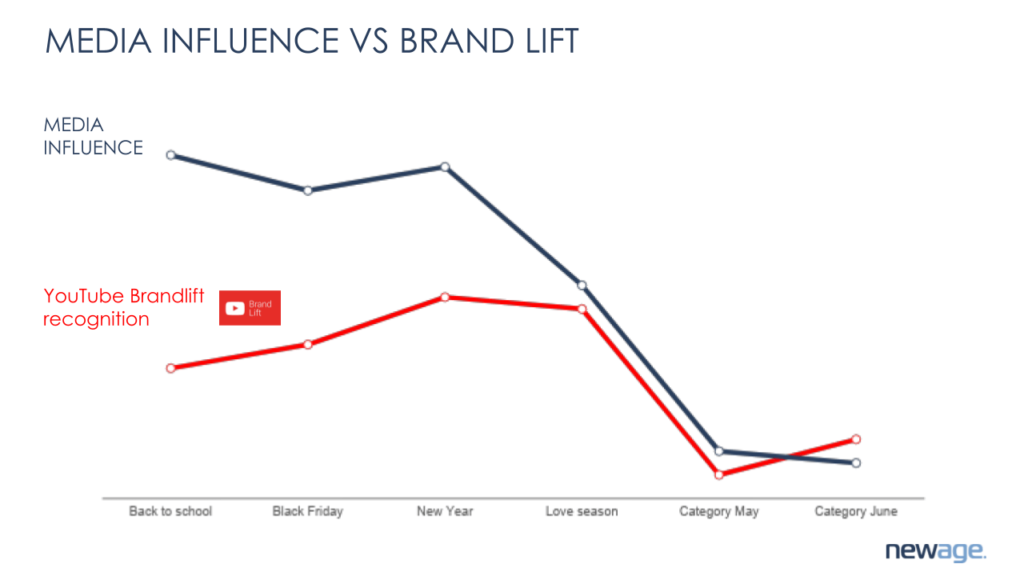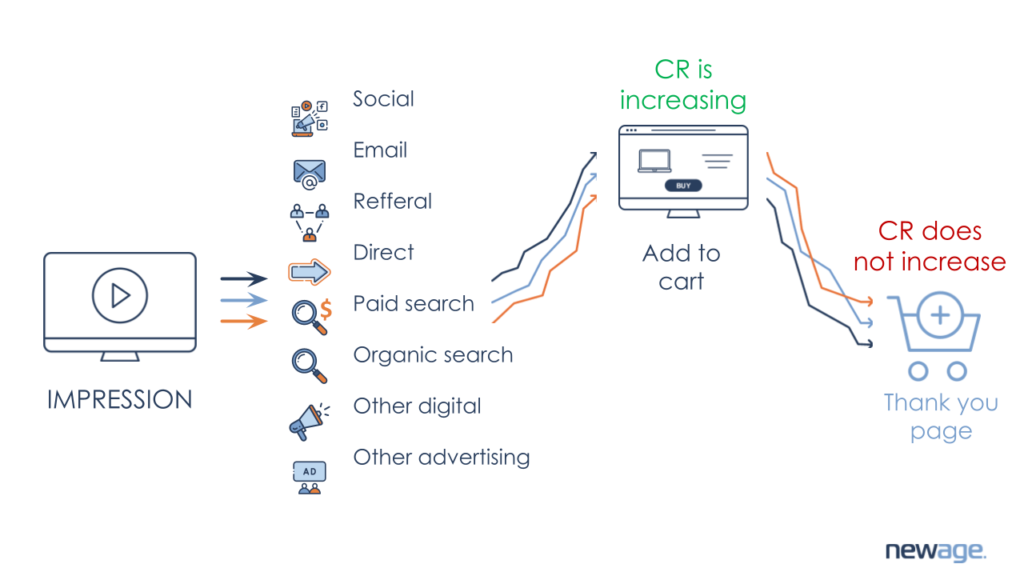How to Measure Display Advertising Impact On Brand And Key Traffic Sources
In this article we describe the role of media advertising in the digital mix and share instructions on how to measure the impact of media advertising on other traffic sources. As an example, Prom’s media advertising campaigns are showcased.

Brandformance: What it is and How to Optimize Media Campaigns with Performance Tools
Brandformance is a targeted media marketing approach derived from the words “brand” and “performance.”
To assess the impact of media advertising on the brand, the agency newage. utilizes Holistic Analysis, which examines data on post-view and cross-device conversions.
Tactical Placement Strategy for Media Advertising
When dealing with several important audience segments:
- Hot segment – ready to make a purchase.
- Warm segment – exploring and considering options.
- Cold segment – unaware of the brand and product.
It is believed that media advertising targets the cold audience to introduce them to the product, while performance tools should be employed for the warm and hot segments. However, media advertising can be beneficial for all segments.
We divide the audiences, select specific formats and targeting for each segment, and establish our own KPIs for each level of the funnel.

Most often, media advertising is evaluated based on clicks. This is an ineffective approach because there are also post-view and cross-device conversions generated by media advertising. If you are unable to track post-view and cross-device conversions, do not rely solely on clicks, as it can lead to mistakes.

- Post-view refers to actions taken by users who have viewed the advertisement and made a conversion from the same device or browser.
- Cross-device refers to actions taken by users who switch from one device to another. It often happens that a user sees an ad on their smartphone on YouTube but makes the conversion on their desktop because it’s more convenient.
There are several other ways to evaluate the impact of media advertising: through brand traffic, search insights, brand lift, month-to-month analysis, or simply by estimation. These are practical methods, but as a MarTech agency, we decided to find a more data-driven approach to evaluation.
We track all media campaigns with Google Campaign Manager’s audience on the client’s website. It allows us to place counters on all ad placements and record who has been shown the advertisement.
On the other hand, we have data from the client, which, in most cases, is Google Analytics. We gather all the data in BigQuery, and at this point, it’s crucial for the User ID to match in both sources. By comparing this data, we observe two user cohorts:
- those who interacted with the advertisement
- those who did not interact with the advertisement.
Consequently, we can compare their behavior and draw conclusions.
The first example is the data from Prom’s “Love Season” campaign, specifically the conversion rate for the “add to cart” action.
We observe an increase across all traffic sources except for Other Advertising, and overall, individuals who have seen the media advertising are 12% more effective. You can read about the effects of other media campaigns in the article titled “How Media Campaigns Influence Performance Tools? Prom Case Study.”
We have been conducting such analysis with Prom for a year now, starting with the first “Back to school” advertising campaign and the latest one being categorical. We have recently extracted the data.
In the first campaign, we estimate a 16% effectiveness of the media, meaning that users who have seen the advertisement are 16% more likely to convert. However, as we approach the end, we observe a decline in “effectiveness.”
These media effect data trendly align with brand lift. Brand lift is a sociological approach, while we have a more data-driven approach, but the data align.
This alignment is reassuring as it confirms the accuracy of our conclusions. Therefore, we can understand the campaign optimization methodology through numbers, and understand why something works.
We decided to go further and examine the impact of media advertising not on the conversion rate but on a deeper conversion—the Thank You page. However, there is no significant growth in this case.
The key objective of media advertising is to bring interested users to the website, encouraging them to browse and add items to the cart. The final conversion, on the other hand, is the task of other tools, such as loyalty programs, convenient delivery, etc.
Next, we decided to look at the traffic shares and how media advertising influences the sources of website traffic.
Among those who did not interact with the media, organic traffic is the largest, followed by paid and direct. However, when we consider those who have seen the advertising, we observe a significant decrease in the share of direct traffic and an increase in the share of paid traffic.
When launching a media campaign, it is important to invest in both the campaign and performance. We had a case where we launched a branding campaign with a large budget, but there was no growth during the campaign.
Upon meeting with the client, we discovered that almost the entire budget was allocated to the media campaign, significantly reducing the budget for paid search.
There is an illusion that a media campaign will immediately bring in many clients or users. But this is just an illusion. Media advertising will impact other sources, and it is not advisable to cut those sources.
Next, we plan to study the effectiveness of different creatives, comparing those who have seen videos versus banners. It is also interesting to compare the media effect based on frequencies, for example, for people who have seen the advertisement 2 times versus 10 times.
Overall, media advertising works. It influences other traffic sources and the behavior of users who have seen the ad videos. However, this effect should be verified in each individual campaign to utilize it correctly.